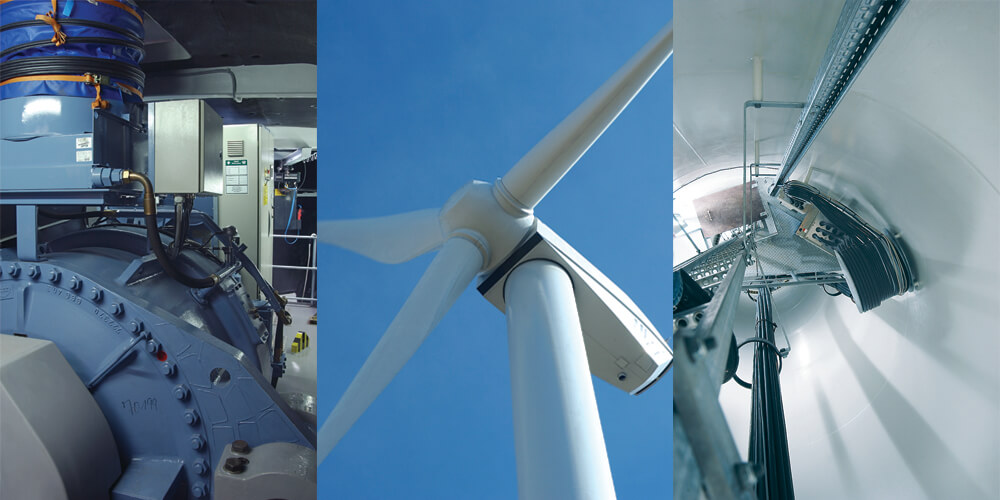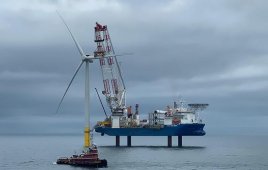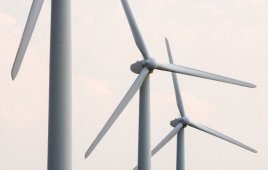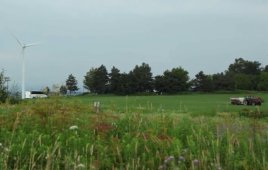By Uwe Schenk
Global Segment Manager – Wind, HELUKABEL
Underwriters Laboratories is a global independent consulting and science company dedicated to product safety. A product with a UL listing ensures that it is in compliance with local safety standards.
Wind turbines have recently come under scrutiny in UL 6141 and UL 6142. These are the first American safety standards developed specifically for wind turbines. These UL standards simplify the approval process for wind-turbine electrical systems and cables through local Authorities Having Jurisdiction (AHJ) inspectors.

Cable performance is critical throughout an entire wind turbine. Two key areas are the nacelle, where cables must withstand exposure to extreme temperatures and lubricants, and the cable loop. Here, cables experience high levels of mechanical stress, such as torsion, from repetitive twisting as the nacelle rotates to maximize a tower’s power output.
In the U.S., AHJs must certify that products are safe to use in accordance with general American installation regulations such as NEC, NESC, and ANSI/IEEE C2, among others. It is not always clear whether components that comply with European CE standards also comply with American installation regulations. If there is doubt, an AHJ inspector may completely shutdown a construction project.
UL 6141 and UL 6142 were formulated to provide a set of rules that help AHJ inspectors with the approval process, making it more transparent and predictable for everyone involved.
Why did North America introduce its own turbine standards?
For years, there were no national safety standards specific to wind turbines in North America. The only guideline AHJs had for reference was the International Electrical Commission (IEC) 61400, which is the international standard for electro-technology in wind turbines.
The IEC standard was never well received, however, and has been criticized in North America for lack of clarity and information. Critics claimed that it did not include enough provisions regarding electrical safety of components, controls, or protection devices.

The HELUWIND WK DLO 2kV-Torsion is a flexible power cable specifically designed for use in wind turbines up to a nominal voltage of 2 kV. It is engineered to withstand the rigorous demands of torsion applications in turbines, such as the cable loop.
UL has since developed national standards to supplement IEC 61400. These standards refer directly to IEC 61400-1 (Design Requirements) and IEC 61400-2 (Small Wind Turbines). They also add technical requirements regarding the safety of electrical, control, and fire protection devices in wind turbines. Essentially, the UL standards help bridge the gap between IEC standards and requirements set by national installation regulations.
American National Standards Institute (ANSI) has recognized UL 6142 (Small Wind-Turbine Systems) as a national standard since 2012. It applies to small turbines, those with a nominal capacity up to 1,500 Vac that cannot or should not be entered by operators or service technicians for operation or maintenance.
In May 2016, ANSI issued UL 6141 (Standard for Wind Turbines Permitting Entry of Personnel) as an American National Standard. UL 6141 applies to large turbines that can or may be entered by operators or service technicians for operation or maintenance. Both UL standards apply exclusively to onshore turbines.
These recent safety standards only effect new construction or refurbishing of wind turbines with a capacity greater than 500 kW. Existing systems need not be refitted.
How does UL 6141 impact the use of cables?
UL 6141 focuses primarily on electrical safety and introduces several restrictions on cable use in the future. The bottom line: appliance wiring material (AWM), or cabling material that is not UL listed, may only be used minimally.
The new HELUKABEL TRAY X is a flexible control power cable with cross-linked polyethylene (XLPE) insulation. Rated for up to 600 V (WTTC 1000 V), these tray cables are suitable for all wind-turbine cable tray applications.
Until now, AWM cables were frequently used in wind turbines. UL 6141 stipulates that:
All accessible cables need to be installed in cable ducts. If this is impractical or impossible (e.g. in the cable loop, only so-called tray cables — cables that are approved for exposed run) are allowed. Cables in the tower and nacelle are usually accessible and, therefore, have to be certified for exposed run as well.
Unlisted AWM cables may no longer be used for exposed runs. Tray cables designed for use as exposed run cables that are oil and flame-resistant fulfill the increased safety requirements of UL 6141. In fact, cables must now hold the UL listing to meet classification as tray cables.
Other UL standards are already in place to regulate components, such as generators, in certain wind-turbine subsystems. These standards continue to apply. UL 6141 will apply to areas that were not previously regulated by a standard.
Local AHJ inspectors already favored UL-listed components because the certification helps standardize and accelerate approval processes. Recognition of UL 6141 as the national safety standard for American markets will make using UL-listed components even more prevalent than before.
Although UL 6141 does not completely rule out the use of AWM cables, it does limit their use to such an extent that UL-listed cable products will likely become the go-to choice for wind turbines.
Filed Under: Cables & connectors, Policy




